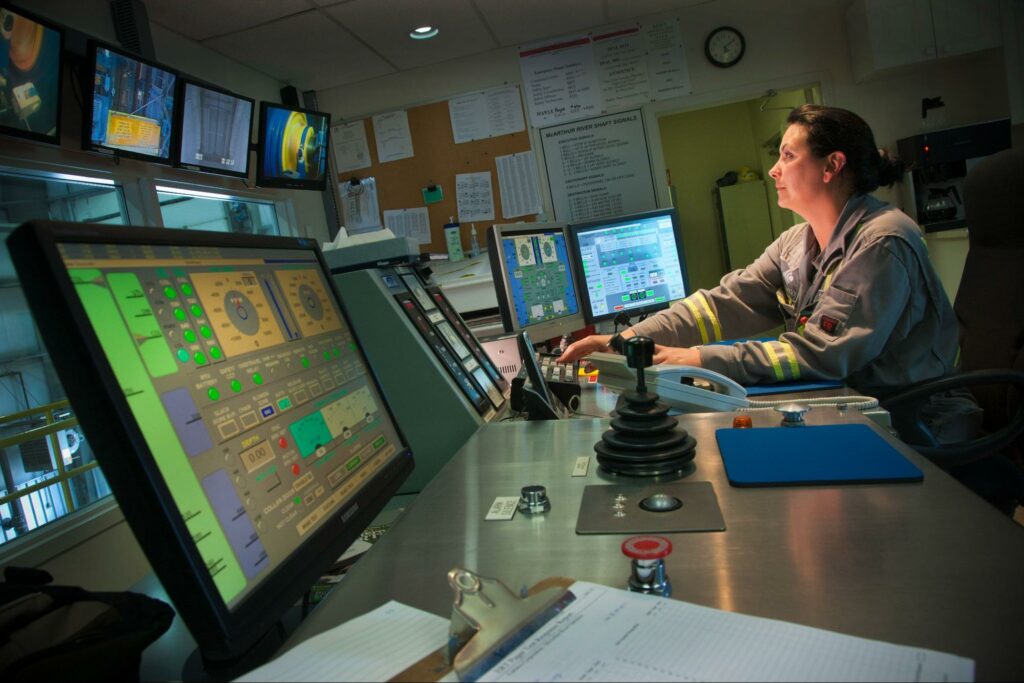When the Saskatchewan minerals industry encounters a challenge, it has an impressive tendency to turn it into an opportunity for growth and improvement. Here are the main challenges and opportunities our minerals industry is facing today.
Technological Change in the Minerals Industry
Minerals operations in Saskatchewan and globally are faced with the opportunity to embrace new technologies all the time. From virtual reality (VR) to automation to artificial intelligence (AI), cutting-edge technology is constantly flooding into mining processes.
- VR is being utilized as an educational tool to better and more safely prepare the upcoming workforce for their day-to-day responsibilities. This can be seen in Saskatchewan Polytechnic’s virtual mine lab and Morris Interactive’s Indigenous pre-employment program.
- BHP’s Jansen Mine Project will be a one-of-a-kind operation, controlled by an Integrated Remote Operating Centre (IROC). The Jansen IROC is run by a single control system with many incredible capabilities, including more sensors collecting data than any other potash mine.
- Mosaic is utilizing a similar technology, an Integrated Operations Centre (IOC), at their Esterhazy mine. The IOC enables workers to control the 13 automated machines that make up their underground fleet.
- Nutrien is doing a lot in the technology space, utilizing tele-remote tech to run an entire mining wing at their Lanigan site without a single person present!
- Cameco is working with a new mining technology, raisebore mining, to address challenging conditions at their McArthur River mine. With this technology, they drill holes from a raisebore chamber into the ore zone and collect the ore with scoop trams that are remote-controlled.
The Minerals Industry’s Response to Climate Change
Many global industries are being affected by calls for increased environmental protection in their processes. Luckily, the minerals industry is no stranger to problem-solving. Major minerals companies in Saskatchewan are taking a large variety of approaches to protecting the environment and reducing emissions.
BHP is committed to reducing their operational emissions by at least 30% by 2030. In addition, they are developing solutions that will create “nature positive” results through conserving, restoring, or regenerating at least 30% of the land and water they steward.
Nutrien is putting a special emphasis on restoring their land post-mining, working with environmental experts to reintroduce native plants and support biodiversity.
Cameco has outlined some impressive targets, with water, GHG emissions, and tailings being the focus of their efforts. Their teams focus on protecting the water near their operations and utilizing best practices for responsible tailings management to protect ecosystems.
Mosaic prioritizes transparency and reporting when it comes to their sustainability initiatives, stating that “reducing our impact is a priority.” They have divided their efforts into land, water, and air. Their land efforts focus on protection and conservation. With water, they are reducing freshwater use, minimizing contamination, and maintaining water quality. With air, they are reducing their GHG emissions, improving energy efficiency, and utilizing internal cogenerated energy.
Public Involvement in the Minerals Industry
As an extractive industry, mining can be a complex subject when it comes to public opinion and support. However, as we embrace innovation, technology, safety and sustainability, the public can see our efforts to grow.
A public opinion survey done by the Saskatchewan Mining Industry in 2022 found that 92% of respondents support the mining industry in Saskatchewan! Furthermore, 91% of respondents were “confident that mining companies will continue to play an important role in Saskatchewan.” When asked, the number one reason respondents support the minerals industry was “job creation/good quality jobs.”
The survey also tackles specifics about sustainability, emissions and jobs – and responses were highly positive. It shows that while the minerals industry is an extractive industry, it is also viewed positively as an important contributor to our province. We are proud to continue sharing the minerals industry’s ability to address challenges through innovation.
The Minerals Industry’s Changing Workforce
As the minerals industry welcomes new generations of workers, we are excited to embrace their diversity, technological skills, and passion for social and environmental causes. IMII offers the iMpowered Scholarship to support women, Indigenous students, mature students, and new immigrants on their mining education journeys. Many minerals companies are also investing in diversity and inclusion:
- BHP is committed to gender balance initiatives in their operations, with a goal to reach gender balance globally by 2025.
- Cameco has been recognized as one of Canada’s Best Diversity Employers since 2010, complying with the federal Employment Equity Act by removing barriers for women in underrepresented roles, people with disabilities, Indigenous people, and members of visible minority groups.
- Mosaic’s approach is based on “Embracing our diversity to be a positive force for change.” Within this, they are striving to achieve 30% women in the workplace, 30% growth in underrepresented groups, and 30% growth in leadership diversity by 2030.
- Nutrien is improving their workforce diversity by removing potential barriers and providing EDI training across all of their global locations.
Another big step for the minerals workforce is the digital transformation and introduction of new technologies. Many minerals companies see this as an opportunity to reskill and retrain employees. In addition, cutting-edge technologies are being incorporated into mining education in Saskatchewan, providing students the opportunity to enter the workforce prepared.
The Saskatchewan minerals industry’s ability to reimagine challenges as opportunities is an important reason it remains competitive on a global scale. We are keeping up with social movements, environmental movements, and technological advancements.
We invite you to stay updated on the minerals industry’s constant growth and adaptation on the IMII news page.



